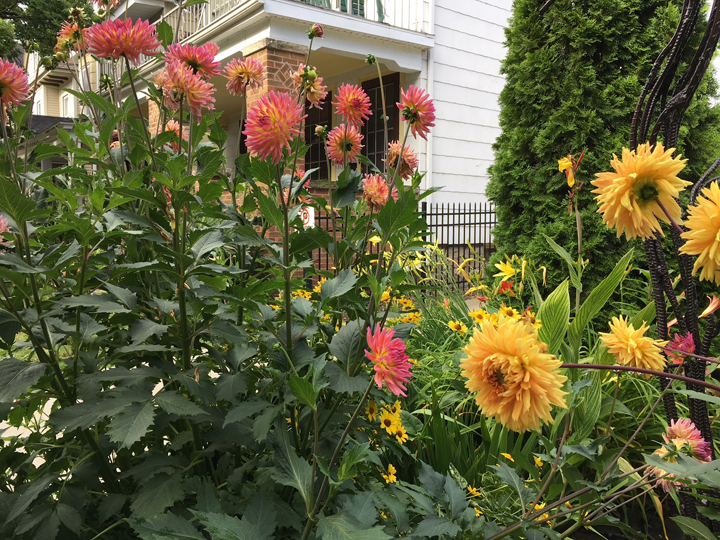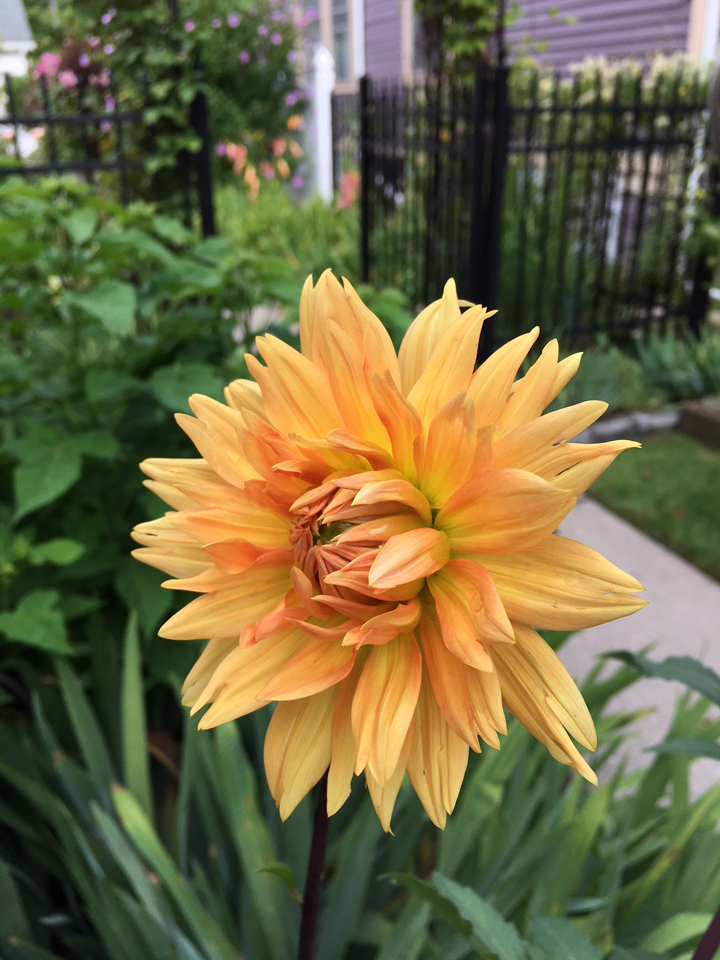
What would September be without dahlias? Oh, there would still be flowers in the garden—anemones, turtlehead, asters, goldenrod, even some hostas—but none of them packs a punch of color like dahlias.
Red, purple, white, pink, yellow, orange, every color but blue can be found in dahlias. They stand on stiff, hollow stems that can be 3 or 4 feet tall, although there are dwarf varieties just 12 or 18 inches high. The flowers may be as simple as a daisy or as many-petaled as a Chinese chrysanthemum. Dahlias have a genetic quirk that makes them especially variable: eight sets of chromosomes, not just two sets like most plants (and us). Having all those chromosomes leads to a lot of genetic diversity, and therefore to many different petal arrangements and colors.
Dahlias grow from tubers, a kind of swollen roots. In their native Mexico or other warm climates, the stalks die back and the roots go dormant when the soil cools in fall, but the tubers stay alive through the winter and resprout in spring. That won’t work in cold climates like Chicago and the Midwest where the soil freezes. When the roots of tender plants like dahlias freeze, they die.
So, if you’re a Midwestern gardener, you have a choice to make. You can think of dahlias as annuals, plant a new set of tubers once the soil warms each May, and let them die in winter. Or, you can dig up the tubers in late fall, store them in a cool, dry place, and replant them in spring. Some gardeners do both, digging up only the tubers of their most special plants. (Of course, you need a meticulous labeling system to know which tubers to dig up.)
A conservatory gives you an edge when it comes to dahlias. In early spring, about March, you can pot up some of your overwintered tubers, water them, and start them growing in the coolest part of the greenhouse. By mid- to late May, when the soil outside is warm enough for tender plants, you’ll have young plants to set out. Because of their head start they may bloom as soon as early August.
If you choose a range of dahlia varieties and stagger the early plantings, you can have a continuous display of dahlias all through August and September.

How about overwintering the tubers in the greenhouse? Bad idea: It will likely be too warm and too moist. The tubers may not stay safely dormant, or they may attract mold and rot. Instead, find a place where you can imitate the conditions of tubers as they overwinter in Mexican soil—dark, dry and cool, but not freezing. Try a cool part of the basement or an unheated attached garage.
Some gardeners pack dahlia tubers in boxes of dry fallen leaves. Others use sawdust or wood shavings (the kind sold for hamster cages). Don’t put the tubers in plastic bags, which trap moisture, but it’s okay to loosely wrap them in newspaper or brown paper lunch bags.
That wrapping gives you a place for the most critical step in overwintering tender tubers and bulbs of all kinds: labeling. Winter is long and memories are short. Label your tubers so you can plan your spring planting and next September’s garden.


